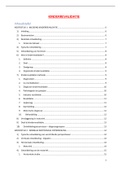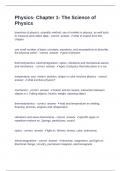KINDERREVALIDATIE
Inhoudstafel
HOOFDSTUK 1 : INLEIDING KINDERREVALIDATIE .................................................................................... 6
1) Inleiding ....................................................................................................................................... 6
2) Basisvereisten .............................................................................................................................. 6
3) Skeletale ontwikkeling................................................................................................................. 7
1. Onderste lidmaat:.................................................................................................................... 7
4) Typische ontwikkeling ................................................................................................................. 7
5) Ontwikkeling van het brein: ........................................................................................................ 8
6) Wat is kinderrevalidatie?............................................................................................................. 8
1. Definitie ................................................................................................................................... 8
2. Doel: ........................................................................................................................................ 8
3. Doelgroep: ............................................................................................................................... 8
4. Organisatie kinderrevalidatie .................................................................................................. 9
7) Kinderrevalidatie methode.......................................................................................................... 9
1. Diagnostiek: ............................................................................................................................. 9
2. Co-morbiditeiten: .................................................................................................................... 9
3. Diagnose kinderrevalidatie .................................................................................................... 10
4. Pathologieën en groepen ...................................................................................................... 10
5. Indicatie revalidatie ............................................................................................................... 10
6. Revalidatie ............................................................................................................................. 11
7. Hulpvraag .............................................................................................................................. 11
8. Aanmelding............................................................................................................................ 12
9. Motorische diagnose: ............................................................................................................ 12
10. Behandeling: ...................................................................................................................... 12
8) Verslaggeving in motoriek ......................................................................................................... 12
9) Doel bij kinderrevalidatie .......................................................................................................... 13
10) Ontwikkelingsstoornissen – diagnosegroepen: .................................................................... 13
HOOFDSTUK 2 : NORMALE MOTORISCHE ONTWIKKELING .................................................................. 14
1) Typische ontwikkeling van verschillende perspectieven .......................................................... 14
2) Verticale ontwikkeling : mijpalen .............................................................................................. 14
3) Horizontale ontwikkeling........................................................................................................... 14
1. Motoriek ................................................................................................................................ 14
4) Ontwikkeling van de motoriek .................................................................................................. 15
1. Horizontale studie: ................................................................................................................ 15
1
, 2. Normale ontwikkeling 3-5 maand: ........................................................................................ 15
3. Observaties: ........................................................................................................................... 15
5) Bewegingsstoornissen ............................................................................................................... 16
1. General movements: ............................................................................................................. 16
2. Classificatie: ........................................................................................................................... 16
6) Sleutelaspecten in de ontwikkeling is de posturale controle.................................................... 16
7) Sleutelactiviteiten: ontwikkeling ............................................................................................... 16
8) Observatie: normale ontwikkeling ............................................................................................ 16
9) Houdings- en bewegingsontwikkeling ....................................................................................... 17
1. Extremiteiten: ........................................................................................................................ 17
2. Romp: .................................................................................................................................... 17
3. Arm-hand motoriek: .............................................................................................................. 17
10) Houdingsreacties ................................................................................................................... 17
11) Kinesiologie en ketentheorie................................................................................................. 17
HOOFDSTUK 3 : MOTOR CONTROL EN MOTORISCH LEREN ................................................................. 18
1) Inleiding ..................................................................................................................................... 18
2) Motor control ............................................................................................................................ 18
1. Motor pathway/banen .......................................................................................................... 18
2. Lateral pathway motor cortex ............................................................................................... 19
3. Anterior medial pathway....................................................................................................... 19
4. Basale ganglia ........................................................................................................................ 20
5. Cerebellum ............................................................................................................................ 21
6. Conclusie ............................................................................................................................... 21
3) Posturale controle ..................................................................................................................... 21
1. Mechanisme posturale controle ........................................................................................... 22
2. Individu-taak-omgeving ......................................................................................................... 22
3. Strategieën: ........................................................................................................................... 22
4) Motorisch leren ......................................................................................................................... 24
1. Theorieën: ............................................................................................................................. 24
2. Stadia: .................................................................................................................................... 25
3. Fasen: .................................................................................................................................... 26
4. Expliciet VS impliciet leren .................................................................................................... 26
5. Instructies: vaardigheden ...................................................................................................... 26
6. Remedial teaching – psychomotoriek: oefening ................................................................... 26
HOOFDSTUK 4 : OBSERVATIE ................................................................................................................ 27
1) Kwantitatieve observatie........................................................................................................... 27
2
, 1. Indeling in globale beweging ................................................................................................. 27
2. Motorische componenten : actie .......................................................................................... 27
3. Soorten informatie : prikkels ................................................................................................. 27
4. Indeling in beweging : vaardigheid........................................................................................ 27
5. Soorten vaardigheden ........................................................................................................... 27
6. Taxonomie van gentile = hoe hoger score, hoe moeilijker de taak ...................................... 28
7. Aard van motorieke taak ....................................................................................................... 28
8. Observatie v/h motoriek ....................................................................................................... 28
9. Psychomotorische componenten.......................................................................................... 28
10. Schema .............................................................................................................................. 29
11. Domein van observatie ..................................................................................................... 29
12. Observatie : hoe en waarom ............................................................................................. 30
13. Verloop v/h bewegingsparcours : 3 momenten ................................................................ 30
2) Kwalitatieve observatie ............................................................................................................. 30
1. Kwaliteit VS kwantiteit .......................................................................................................... 30
2. Ontwikkelingsstoornissen : denkkader ................................................................................. 30
3. OBSERVABLE MOVEMENT QUALITY SCALE ........................................................................... 30
4. Observatie van kwaliteit ........................................................................................................ 31
5. Samenvattend ....................................................................................................................... 31
HOOFDSTUK 5 : Psychomotorisch, functioneel, klinisch en neurologisch onderzoek .......................... 32
1) Inleiding ..................................................................................................................................... 32
1) Meetinstrumenten .................................................................................................................... 32
2) Capaciteiten profiel ................................................................................................................... 33
3) Range of motion ........................................................................................................................ 33
4) 6-MWT ....................................................................................................................................... 33
5) Gross Motor Function Measure GMFM ................................................................................... 34
6) Motor Function Measure MFM ................................................................................................. 34
7) Pediatric Evaluation of Disability Inventory PEDI-NL................................................................ 34
8) Goal Attainment Scaling GAS .................................................................................................... 34
9) AIMS (Alberta Infant Motor Scale) ............................................................................................ 35
10) Bayley ontwikkeling scale ...................................................................................................... 35
11) M ABC-2 ................................................................................................................................. 35
12) BOT-2 ..................................................................................................................................... 35
13) KTK-NL ................................................................................................................................... 36
14) VSST ....................................................................................................................................... 36
15) SOS (Systematische opsporing schrijfproblemen) ................................................................ 36
3
, 16) VMI (Visuele motorische integratie) ..................................................................................... 36
17) WRAVMA ............................................................................................................................... 36
18) DTVP-2/DTVP-3 ..................................................................................................................... 37
19) Observaties ............................................................................................................................ 37
1. Grove motoriek: .................................................................................................................... 37
2. Fijne motoriek: ...................................................................................................................... 37
3. Grafomotoriek ....................................................................................................................... 37
4. Visuele waarneming .............................................................................................................. 38
5. Visueel – ruimtelijke perceptie.............................................................................................. 38
6. Observable movement quality scale ..................................................................................... 38
20) Klinisch onderzoek................................................................................................................. 39
HOOFDSTUK 6 : Developmental coordination disorder DCD ................................................................ 40
1) DSM5-criteria: ........................................................................................................................... 40
2) DCD, mijn drijfveer .................................................................................................................... 41
3) DCD beleven: 5G’s ..................................................................................................................... 41
4) DCD klinisch beeld ..................................................................................................................... 41
1. ‘Signalen’ bij baby’s en peuters ............................................................................................. 41
2. Moeilijkheden bij kinderen met DCD i/h kleuteronderwijs .................................................. 41
3. Moeilijkheden bij kinderen met DCD i/h lager onderwijs ..................................................... 42
4. Zelfredzaamheid/ zelfstandigheid ......................................................................................... 42
5. Moeilijkheden bij kinderen met DCD i/h secundaire onderwijs ........................................... 42
6. Chronisch, volwassenen met DCD ......................................................................................... 43
5) DCD Heterogeen beeld .............................................................................................................. 43
1. Interpersoonlijke verschillen ................................................................................................. 43
2. Biologisch............................................................................................................................... 43
3. Psychologisch ........................................................................................................................ 43
4. Sociaal.................................................................................................................................... 44
6) Oorzaak idiopathisch ................................................................................................................. 44
7) Grote comorbiditeit: differentiaaldiagnostiek .......................................................................... 44
8) Gevolgen, impact DCD ............................................................................................................... 44
HOOFDSTUK 7 : Ganganalyse ................................................................................................................ 59
1) Ganganalyse bij kinderen .......................................................................................................... 59
1. Basiskenmerken .................................................................................................................... 59
2. 3D ganganalyse binnen ICF.................................................................................................... 59
3. Uitleg specifieke taal bij ganganalyse.................................................................................... 59
4. Beschrijving op grafieken ...................................................................................................... 60
4
Inhoudstafel
HOOFDSTUK 1 : INLEIDING KINDERREVALIDATIE .................................................................................... 6
1) Inleiding ....................................................................................................................................... 6
2) Basisvereisten .............................................................................................................................. 6
3) Skeletale ontwikkeling................................................................................................................. 7
1. Onderste lidmaat:.................................................................................................................... 7
4) Typische ontwikkeling ................................................................................................................. 7
5) Ontwikkeling van het brein: ........................................................................................................ 8
6) Wat is kinderrevalidatie?............................................................................................................. 8
1. Definitie ................................................................................................................................... 8
2. Doel: ........................................................................................................................................ 8
3. Doelgroep: ............................................................................................................................... 8
4. Organisatie kinderrevalidatie .................................................................................................. 9
7) Kinderrevalidatie methode.......................................................................................................... 9
1. Diagnostiek: ............................................................................................................................. 9
2. Co-morbiditeiten: .................................................................................................................... 9
3. Diagnose kinderrevalidatie .................................................................................................... 10
4. Pathologieën en groepen ...................................................................................................... 10
5. Indicatie revalidatie ............................................................................................................... 10
6. Revalidatie ............................................................................................................................. 11
7. Hulpvraag .............................................................................................................................. 11
8. Aanmelding............................................................................................................................ 12
9. Motorische diagnose: ............................................................................................................ 12
10. Behandeling: ...................................................................................................................... 12
8) Verslaggeving in motoriek ......................................................................................................... 12
9) Doel bij kinderrevalidatie .......................................................................................................... 13
10) Ontwikkelingsstoornissen – diagnosegroepen: .................................................................... 13
HOOFDSTUK 2 : NORMALE MOTORISCHE ONTWIKKELING .................................................................. 14
1) Typische ontwikkeling van verschillende perspectieven .......................................................... 14
2) Verticale ontwikkeling : mijpalen .............................................................................................. 14
3) Horizontale ontwikkeling........................................................................................................... 14
1. Motoriek ................................................................................................................................ 14
4) Ontwikkeling van de motoriek .................................................................................................. 15
1. Horizontale studie: ................................................................................................................ 15
1
, 2. Normale ontwikkeling 3-5 maand: ........................................................................................ 15
3. Observaties: ........................................................................................................................... 15
5) Bewegingsstoornissen ............................................................................................................... 16
1. General movements: ............................................................................................................. 16
2. Classificatie: ........................................................................................................................... 16
6) Sleutelaspecten in de ontwikkeling is de posturale controle.................................................... 16
7) Sleutelactiviteiten: ontwikkeling ............................................................................................... 16
8) Observatie: normale ontwikkeling ............................................................................................ 16
9) Houdings- en bewegingsontwikkeling ....................................................................................... 17
1. Extremiteiten: ........................................................................................................................ 17
2. Romp: .................................................................................................................................... 17
3. Arm-hand motoriek: .............................................................................................................. 17
10) Houdingsreacties ................................................................................................................... 17
11) Kinesiologie en ketentheorie................................................................................................. 17
HOOFDSTUK 3 : MOTOR CONTROL EN MOTORISCH LEREN ................................................................. 18
1) Inleiding ..................................................................................................................................... 18
2) Motor control ............................................................................................................................ 18
1. Motor pathway/banen .......................................................................................................... 18
2. Lateral pathway motor cortex ............................................................................................... 19
3. Anterior medial pathway....................................................................................................... 19
4. Basale ganglia ........................................................................................................................ 20
5. Cerebellum ............................................................................................................................ 21
6. Conclusie ............................................................................................................................... 21
3) Posturale controle ..................................................................................................................... 21
1. Mechanisme posturale controle ........................................................................................... 22
2. Individu-taak-omgeving ......................................................................................................... 22
3. Strategieën: ........................................................................................................................... 22
4) Motorisch leren ......................................................................................................................... 24
1. Theorieën: ............................................................................................................................. 24
2. Stadia: .................................................................................................................................... 25
3. Fasen: .................................................................................................................................... 26
4. Expliciet VS impliciet leren .................................................................................................... 26
5. Instructies: vaardigheden ...................................................................................................... 26
6. Remedial teaching – psychomotoriek: oefening ................................................................... 26
HOOFDSTUK 4 : OBSERVATIE ................................................................................................................ 27
1) Kwantitatieve observatie........................................................................................................... 27
2
, 1. Indeling in globale beweging ................................................................................................. 27
2. Motorische componenten : actie .......................................................................................... 27
3. Soorten informatie : prikkels ................................................................................................. 27
4. Indeling in beweging : vaardigheid........................................................................................ 27
5. Soorten vaardigheden ........................................................................................................... 27
6. Taxonomie van gentile = hoe hoger score, hoe moeilijker de taak ...................................... 28
7. Aard van motorieke taak ....................................................................................................... 28
8. Observatie v/h motoriek ....................................................................................................... 28
9. Psychomotorische componenten.......................................................................................... 28
10. Schema .............................................................................................................................. 29
11. Domein van observatie ..................................................................................................... 29
12. Observatie : hoe en waarom ............................................................................................. 30
13. Verloop v/h bewegingsparcours : 3 momenten ................................................................ 30
2) Kwalitatieve observatie ............................................................................................................. 30
1. Kwaliteit VS kwantiteit .......................................................................................................... 30
2. Ontwikkelingsstoornissen : denkkader ................................................................................. 30
3. OBSERVABLE MOVEMENT QUALITY SCALE ........................................................................... 30
4. Observatie van kwaliteit ........................................................................................................ 31
5. Samenvattend ....................................................................................................................... 31
HOOFDSTUK 5 : Psychomotorisch, functioneel, klinisch en neurologisch onderzoek .......................... 32
1) Inleiding ..................................................................................................................................... 32
1) Meetinstrumenten .................................................................................................................... 32
2) Capaciteiten profiel ................................................................................................................... 33
3) Range of motion ........................................................................................................................ 33
4) 6-MWT ....................................................................................................................................... 33
5) Gross Motor Function Measure GMFM ................................................................................... 34
6) Motor Function Measure MFM ................................................................................................. 34
7) Pediatric Evaluation of Disability Inventory PEDI-NL................................................................ 34
8) Goal Attainment Scaling GAS .................................................................................................... 34
9) AIMS (Alberta Infant Motor Scale) ............................................................................................ 35
10) Bayley ontwikkeling scale ...................................................................................................... 35
11) M ABC-2 ................................................................................................................................. 35
12) BOT-2 ..................................................................................................................................... 35
13) KTK-NL ................................................................................................................................... 36
14) VSST ....................................................................................................................................... 36
15) SOS (Systematische opsporing schrijfproblemen) ................................................................ 36
3
, 16) VMI (Visuele motorische integratie) ..................................................................................... 36
17) WRAVMA ............................................................................................................................... 36
18) DTVP-2/DTVP-3 ..................................................................................................................... 37
19) Observaties ............................................................................................................................ 37
1. Grove motoriek: .................................................................................................................... 37
2. Fijne motoriek: ...................................................................................................................... 37
3. Grafomotoriek ....................................................................................................................... 37
4. Visuele waarneming .............................................................................................................. 38
5. Visueel – ruimtelijke perceptie.............................................................................................. 38
6. Observable movement quality scale ..................................................................................... 38
20) Klinisch onderzoek................................................................................................................. 39
HOOFDSTUK 6 : Developmental coordination disorder DCD ................................................................ 40
1) DSM5-criteria: ........................................................................................................................... 40
2) DCD, mijn drijfveer .................................................................................................................... 41
3) DCD beleven: 5G’s ..................................................................................................................... 41
4) DCD klinisch beeld ..................................................................................................................... 41
1. ‘Signalen’ bij baby’s en peuters ............................................................................................. 41
2. Moeilijkheden bij kinderen met DCD i/h kleuteronderwijs .................................................. 41
3. Moeilijkheden bij kinderen met DCD i/h lager onderwijs ..................................................... 42
4. Zelfredzaamheid/ zelfstandigheid ......................................................................................... 42
5. Moeilijkheden bij kinderen met DCD i/h secundaire onderwijs ........................................... 42
6. Chronisch, volwassenen met DCD ......................................................................................... 43
5) DCD Heterogeen beeld .............................................................................................................. 43
1. Interpersoonlijke verschillen ................................................................................................. 43
2. Biologisch............................................................................................................................... 43
3. Psychologisch ........................................................................................................................ 43
4. Sociaal.................................................................................................................................... 44
6) Oorzaak idiopathisch ................................................................................................................. 44
7) Grote comorbiditeit: differentiaaldiagnostiek .......................................................................... 44
8) Gevolgen, impact DCD ............................................................................................................... 44
HOOFDSTUK 7 : Ganganalyse ................................................................................................................ 59
1) Ganganalyse bij kinderen .......................................................................................................... 59
1. Basiskenmerken .................................................................................................................... 59
2. 3D ganganalyse binnen ICF.................................................................................................... 59
3. Uitleg specifieke taal bij ganganalyse.................................................................................... 59
4. Beschrijving op grafieken ...................................................................................................... 60
4



